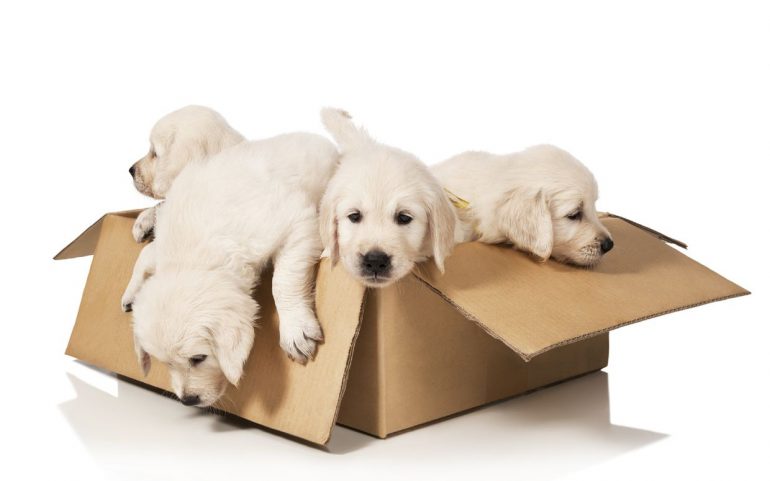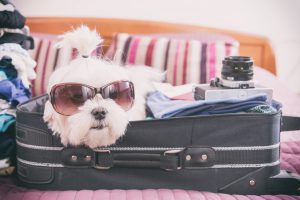Moving is stressful for everyone involved, canine companions included. Dogs thrive on routine and moving can seriously upset the rhythms of their lives. It may take your pup weeks or months to fully adjust to her new environment. Whether you’re moving down the block or across the country, follow these 10 tips to help ease your dog into your new home.
Acclimate ahead of time
You can start helping your dog adjust to the idea of moving before you even make the move. Try leaving out some boxes and suitcases ahead of time, so your dog gets used to them and doesn’t think you’re about to leave without him. In addition, if your dog will have to live by new rules in the new place—such as barking less because of closer neighbors—start training towards these goals before the move. If you’re close enough to your new digs, you can also take your dog for walks in the area ahead of the move so he gets used to the sights and smells beforehand.
Get your pup’s ID in order
Make sure your dog has a secure collar with tags and contact and information. Don’t forget you might need to update their tags after you move, depending on how far away you’re relocating. If possible, get your dog microchipped in case the worst happens and you get separated during the move. You don’t want to leave your reunion to canine instincts and chance. Make sure you keep medical records and a current photo with you as well in case of emergencies.
Give them a break on the big day
Boarding your dog for a day or several days while you complete the final packing can go a long way towards easing her stress. You can leave her with a friend, kennel her or enlist the help of a professional pet sitter to watch her. If you’re moving close by, you can keep boarding your dog until you’re unpacked and set up in the new house so she doesn’t have to endure the chaos of moving in.
Pet-proof your new place
Before letting Rover in the house or yard, do your due diligence to take care of any hazards ahead of time. Make sure there are no gaps in the fence and that all gates securely latch. If your dog is prone to getting into cabinets, install child-safe locks to prevent him from opening doors. If there are any dog doors installed, make sure they work properly. As you unpack, also keep an eye out for dangerous items such as cleaning supplies and be sure to keep them away from your pup.
Pack your pup’s things last…
Whether it’s her comfy old bed or several favorite dog toys (or both), try leaving out your pup’s things until the last possible moment. This will give her a sense of security even as things are being packed up around her. Amidst all the change, she’ll have familiar objects that still smell like her and the old house. To keep the sense of continuity, you can even bring some of the things with you as you travel if your mode of transportation allows for it.
…and unpack them first, if possible
If you can, try to unpack your dog’s things early on in the move. And if you’re biomedical neurontin tempted to wash anything of your pup’s, don’t: The familiar smell will help her acclimate more quickly to the new place. You might need to confine your dog to one room or floor while you get the boxes into the house, but as soon as you can, set up the beds, bowls and other items in a similar configuration to the old house. So, if your pup’s bed was in the living room before, try to place it in the living room again, and so on. This configuration will also help to create a feeling of familiarity for your pup.
Help your pup de-stress
There are many ways you can help decrease your dog’s stress levels when you move to a new home. Sticking to the schedule you established prior to moving will help create a sense of routine when it comes to eating, walking and using the bathroom. Calming dog treats or CBD biscuits and oils can help him relax naturally if he seems keyed up. Frequent walks, exercise and playtime will also tire your dog out and help him rest easier—not to mention it will probably reduce your stress, too.
Explore a little bit at a time
Give your dog time to slowly get used to your neighborhood or city. Start with short walks, to begin with, then slowly increase your radius as you range further and further away. Introduce your dog slowly to the sights and sounds of new places, such as a community pool or basketball court. Even if your dog is normally the model of obedience, keep him on a leash–at least in the beginning. It’s a totally new environment for him and he doesn’t understand what’s going on, which can lead to running off and other erratic behavior.
Create a positive environment
You want your dog to associate the new place with good things, so try to carve out some time from unpacking to create a few fun memories together. Throw the ball in the backyard, cuddle on the couch or give your dog her favorite puzzle toy filled with peanut butter in the living room. This will help your dog connect the new home with positive experiences.
Above all, be patient
It usually takes dogs about three weeks to settle into a new environment, and some may take longer, especially if the move was drastic. However, behavioral changes can take several months or longer to take effect. Be as patient as you can with your dog, and put yourself in his shoes (or rather, paws): Everything looks, smells and sounds different, so it’s going to take some time to adjust.
Your dog will undoubtedly have a period of adjustment to your new place but following these guidelines can help her acclimate faster. The sooner you set a routine and begin creating positive experiences in the new place, the sooner your apartment or house will feel like a home to your pup.
Author Bio: Jordan Smith is a full-time stay-at-home mother of 2 daughters and a new dog Luna! She loves blogging, crafting, and spending time with her family. She also enjoys strolling the streets of downtown Charleston, South Carolina and all the amazing food her hometown has to offer.




